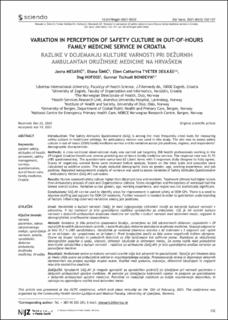| dc.contributor.author | Mesarić, Jasna | |
| dc.contributor.author | Šimić, Diana | |
| dc.contributor.author | Deilkås, Ellen C Tveter | |
| dc.contributor.author | Hofoss, Dag | |
| dc.contributor.author | Bondevik, Gunnar Tschudi | |
| dc.date.accessioned | 2022-02-01T12:02:02Z | |
| dc.date.available | 2022-02-01T12:02:02Z | |
| dc.date.created | 2021-07-20T21:43:47Z | |
| dc.date.issued | 2021 | |
| dc.identifier.citation | Slovenian Journal of Public Health. 2021, 60 (3), 152-157. | en_US |
| dc.identifier.issn | 0351-0026 | |
| dc.identifier.uri | https://hdl.handle.net/11250/2976253 | |
| dc.description.abstract | Introduction The Safety Attitudes Questionnaire (SAQ) is among the most frequently cited tools for measuring safety culture in healthcare settings. Its ambulatory version was used in this study. The aim was to assess safety culture in out-of-hours (OOH) family medicine service and its variation across job positions, regions, and respondents’ demographic characteristic. Methods A cross-sectional observational study was carried out targeting 358 health professionals working in the 29 largest Croatian healthcare centres providing out-of-hours family medicine service. The response rate was 51.7% (185 questionnaires). The questionnaire comprised 62 Likert items with 5 responses (fully disagree to fully agree). Scores of negatively worded items were reversed before analysis. Scores on the total scale and subscales were calculated as additive scores. The study included demographic data on gender, age, working experience, and job position. Repeated measurement analysis of variance was used to assess variation of Safety Attitudes Questionnaire – Ambulatory Version (SAQ-AV) sub-scales. Results Nurses assessed safety culture higher than did physicians and residents. Teamwork climate had higher scores than Ambulatory process of care and Organizational climate. Stress recognition and Perceptions of workload had the lowest overall scores. Variation across gender, age, working experience, and region was not statistically significant. Conclusions SAQ-AV can be used to identify areas for improvement in patient safety at OOH GPs. There is a need to improve staffing and support for OOH GP residents. Further research is needed in order to gain better understanding of factors influencing observed variations among job positions. | en_US |
| dc.language.iso | eng | en_US |
| dc.rights | Attribution-NonCommercial-NoDerivs 3.0 IGO (CC BY-NC-ND 3.0 IGO) | * |
| dc.rights.uri | https://creativecommons.org/licenses/by-nc-nd/3.0/ | * |
| dc.title | Variation in perception of safety culture in out-of-hours family medicine service in Croatia Razlike v dojemanju kulture varnosti pri dežurnih ambulantah družinske medicine na Hrvaškem | en_US |
| dc.type | Journal article | en_US |
| dc.type | Peer reviewed | en_US |
| dc.rights.holder | © 2021 National Institute of Public Health, Slovenia | en_US |
| dc.description.version | publishedVersion | en_US |
| cristin.ispublished | true | |
| cristin.fulltext | original | |
| cristin.qualitycode | 1 | |
| dc.identifier.doi | 10.2478/sjph-2021-0022 | |
| dc.identifier.cristin | 1922277 | |
| dc.source.journal | Slovenian Journal of Public Health | en_US |
| dc.source.volume | 60 | en_US |
| dc.source.issue | 3 | en_US |
| dc.source.pagenumber | 152-157 | en_US |

